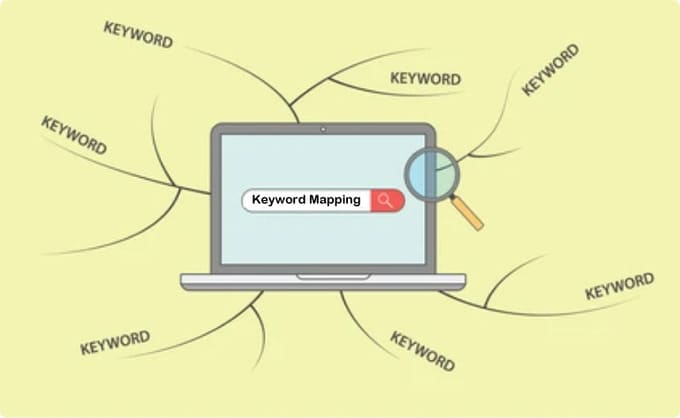How To Search For Keywords With Keyword Mapping

Keyword Mapping: The Secret to Targeted Traffic and Boosted Rankings
Let’s get straight to the point; if you’re tired of your website languishing on the wrong end of search results, it’s time to get strategic. No fluff, just facts.
You have to know how to search for keywords. Keyword mapping is your ticket to aligning your content with the terms your potential customers are actually searching for.
Think of it as connecting the dots between what you offer and what your audience needs. It’s essential for achieving online success in today’s digital landscape.
In this article, I’ll walk you through the essentials: what keyword mapping really means, and how you can implement it without getting lost in the weeds.
It’s interesting to know that this is a game-changer for boosting your online visibility and driving qualified traffic.
Grab your coffee, clear your schedule for the next few minutes, and let’s break down how keyword mapping can elevate your SEO strategy. Now you can finally put your website where it belongs: right in front of your ideal clients.
Click here for my #1 recommendation for making money online while working from home
What is Keyword Mapping?
Keyword mapping is the process of identifying relevant keywords for your website and match them to the appropriate pages on your site.
By doing this, you can ensure that your site is optimized for the search engines. Visitors will then be able to find the information they are looking for easily.
There are a few different methods that you can use to map keywords to your website. The most important thing is to make sure that you are thinking about the user intent when selecting keywords.
First you have to identify a list of potential keywords. You can use a variety of tools to help you match them to the right pages on your site.
One of the most important things to keep in mind when keyword mapping is that your goal should be to create a user-friendly experience.
This means that you should avoid using too many keywords on a single page. This can make it difficult for visitors to read and understand. Instead, focus on creating informative and well-written content that uses keywords naturally.
You need to take the time to map out your keywords correctly. Only then can you reap the benefits of targeted traffic and improved rankings in the search engines.
Not only will this help bring more visitors to your website, but it can also lead to increased sales and conversions. So if you want to get more from your online marketing efforts, start by taking a closer look at keyword mapping!
Benefits of Keyword Mapping
There are many benefits to keyword mapping, including:
1. Increased targeted traffic: By targeting specific keywords, you can attract more visitors who are actually interested in what you have to offer.
2. Boosted rankings: Keyword mapping can help improve your search engine rankings for your targeted keywords, resulting in more visibility and traffic.
3. Greater ROI: By attracting more targeted traffic and improving your search engine rankings, you’ll likely see a higher return on investment for your marketing efforts.
4. Improved usability: Keyword mapping can help make your website more user-friendly by helping visitors find what they’re looking for more easily.
5. Enhanced customer experience: Providing a better experience for your customers will keep them coming back. It will also encourage them to tell others about your site.

How to Search for the Right Keywords
If you’re serious about driving targeted traffic to your website, then you need to be strategic about the keywords you target.
The right keywords will help you attract the right kind of visitors, who are more likely to convert into customers or leads. Here’s how to find the right keywords for your business:
1. Start with brainstorming.
Get a group of people together (employees, friends, family, etc.) and start brainstorming potential keywords. Write down any and every word or phrase that comes to mind, no matter how relevant it seems. You can always narrow down your list later on.
2. Use keyword research tools.
First you need to have a good list of potential keywords. Next you need to use keyword research tools to help you research their popularity and competitiveness. Google AdWords Keyword Planner and Moz Keyword Explorer are two great options.
Just enter in your list of keywords and see what comes back in terms of monthly search volume and difficulty level. This will help you narrow down your list even further.
3. Consider your audience.
When choosing keywords, it’s important to think about who your target audience is and what they might be searching for. For example, if you sell children’s toys, then parents or guardians are likely your target market.
What words or phrases would they use when searching for products like yours? Make sure to include these in your final keyword list.
4. Map out your keywords.
Organize keywords in relevant categories to create targeted content that attract the right audience. You can use Ubersuggest to find even more keywords.
Use these keywords to update pages or write new articles based on these keywords.
Click here for my #1 recommendation for making money online while working from home
Strategies for Optimizing Your Content with Keywords
The process of keyword mapping is vital to the success of any content marketing strategy.
By aligning your content with the right keywords, you can ensure that your target audience will see your content in search results. They will be more than likely to click through to your site. Here are some tips for optimizing your content with keywords:
1. Use keyword research tools to identify the right keywords for your content.
2. Use those keywords throughout your content, including in the title, in the body, and in the meta tags.
3. Make sure that your keywords are relevant to your topic and audience.
4. Use a variety of different keyword phrases to ensure that your content appears in a variety of different search results.
5. Monitor your keyword rankings over time to ensure that your content is being found by searchers and is helping you achieve your desired results.
Tools to Help You Map Your Keywords
There are a number of tools that can help you map your keywords and ensure that you are targeting the right ones.
The Google AdWords Keyword Planner is a great place to start, as it can help you see how often certain keywords are being searched for. You can also use Google Trends to see which keywords are gaining popularity over time.
Other tools that can be helpful include wordtracker.com and semrush.com. These websites offer keyword research tools that can help you narrow down your options and find the right keywords to target.
By taking the time to map out your keywords, you can ensure that your website is getting the targeted traffic it needs to boost its ranking in search engines.
Tips for Implementing Keyword Mapping
1. Define your keyword targets.
Before you can map keywords to your content, you need to know what keywords you’re targeting. Do some research to identify the key phrases that are most relevant to your business and that have a high search volume.
Once you’ve identified your targets, you can start mapping them to your content.
2. Map keywords to existing content.
Now that you know which keywords you want to target, it’s time to start mapping them to your existing content. If you already have blog posts or articles that are relevant to the keywords you’re targeting, simply add those keywords into the mix.
If you don’t have any existing content that’s relevant to the keywords you’re targeting, consider creating new pieces specifically for these target keywords.
3. Create new content for targeted keywords.
Blog posts, articles, infographics, and even videos are all great options for targeting specific keywords. By creating new, keyword-targeted content, you’ll be able to attract more targeted traffic and boost your search engine rankings.
Click here for my #1 recommendation for making money online while working from home
Conclusion
Keyword mapping is an essential practice for any business looking to increase their online presence and get more targeted traffic. You have to understand the search intent behind each keyword and create a detailed strategy around it.
By doing so you can create content that will help you rank higher in searches and drive more qualified leads to your website.
Keyword mapping has the ability to boost rankings, target specific audiences, and generate organic traffic. So keyword mapping should be an integral part of every digital marketing strategy.
Thanks for reading this article about how to search for keywords with keyword mapping.

